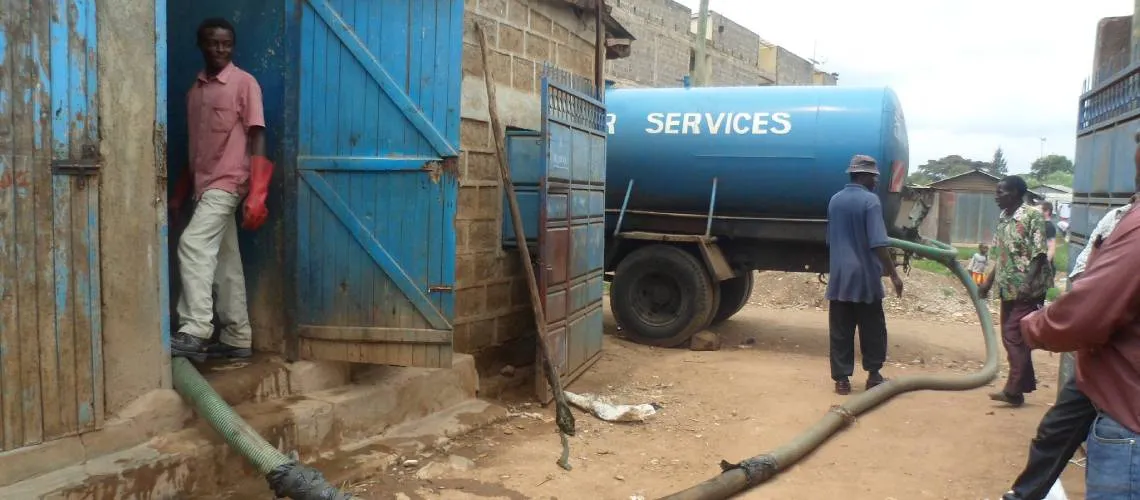Is non-sewered sanitation the missing piece of the access puzzle for Kenya?
By Lewnida Sara, Joy Busolo, Neema Mwingu, James Origa & Pascaline Wanjiku Ndungu

The challenge of providing a safe and dignified means to undertake humankind’s most basic bodily function is characterized by two extremes in Kenya. On one end of the spectrum, ambitious sewerage systems are often paralyzed by inadequate resources and feasibility constraints. On the other, open defecation and flying toilets – the practice of defecating in a plastic bag and then discarding it in the open – are the options of last resort for those without even the most basic latrine facilities. The result is a gap in access to safely managed sanitation that impacts a quarter of Kenya’s population, according to the 2019 census data.
But where toilet facilities are lacking, innovation and entrepreneurship are not. From locally-built containment units to pit-emptying services undertaken manually by individuals – locally referred to as “froggers” – or sometimes facilitated by vacuum tankers – known colloquially as “honeysuckers” – informal service workers and small formal facility operators have stepped in to fill the gap.
While the National Water and Sanitation Investment Plan sets a target of 40 percent sewer coverage by 2030, the government recognizes the potential of incorporating non-sewered options as a complement to traditional sewered approaches in order to achieve 100 percent coverage of safely managed sanitation. But doing so will require a seismic shift in how sanitation services are conceptualized, managed, and delivered. At its core, it will call for greater involvement of private operators possessing the necessary financial, technical, and management resources that enable them to deliver quality NSS services. The most efficient, cost-effective, and productive avenue to achieve this is to leverage what is already happening in the NSS space. Adopting a public-private-partnership (PPP) approach for the provision of NSS services offers an avenue for doing so, while also enabling WSPs to quickly scale-up service delivery to meet national sanitation targets. However, this is not without its challenges.
Under Kenya’s devolved government structure, responsibility for WSS service delivery sits with the individual counties. Historically there has been a tendency to prioritize water supply over sanitation, a consequence of limited public resources, narrow sanitation service options outside of sewered networks, and a gap in the regulatory framework that would enable counties to contract the private sector to deliver services.
Additionally, while the existing fledgling and largely informal private sector presence in the sanitation market is performing a vital service, it is on a small, fragmented scale and providers have limited access to financial resources to grow their businesses. In practice, this means that most of the services provided may not meet basic standards of safety. Containment facilities may be inadequate and not designed to ensure that they can be emptied. This leads to overflow during rains and, ultimately, abandonment resulting in a gradually increasing risk of infiltration with drinking water supply. In cases where containment units can be emptied, most of the fecal sludge – upwards of 80 percent – is not disposed of safely, but rather illegally dumped into nearby waterways due to the relatively high cost of formal emptying services and the limited availability of safe treatment facilities.
Formalizing the existing value chain will require addressing these technical and market failures, as well as developing a supportive regulatory and policy environment to empower counties to successfully engage with the private sector. A new World Bank report – Market-Based Models and Public-Private Partnership Options for Non-Sewered Sanitation in Selected Cities and Towns in Kenya – provides a roadmap for addressing these challenges and rolling-out sanitation PPPs. Estimates show that the potential of PPPs for NSS services is about $27.5 million a year. The report identifies replicable, market-based business models across the sanitation chain and provides a menu of PPP options for scaling-up NSS services:
- A containment PPP model for improved on-site sanitation (OSS) based on standard designs with predefined fixed household payment, targeting low-income households.
- An emptying and transport PPP model for affordable, environmentally safe emptying services through performance-based financing, targeting vacuum truck operators (VTOs) and manual emptying operators.
- A treatment and reuse PPP model for third-party operation and maintenance (O&M) of government-owned fecal sludge treatment plants (FSTPs).
The report also lays out a framework for capacity-building and enabling environment reforms that are necessary to unlock PPPs. These include the development and implementation of clear regulatory and policy reforms to enable county governments and WSPs to contract private sector actors; the prioritization of sanitation investments in county budgets and county integrated development plans (CIDPs); and the creation of incentives to promote NSS investments at county and WSP levels.
The Malindi Water and Sanitation Company (Mawasco) is already working to prove that the proposed approach can succeed in Kenya. In 2020 the utility completed a City-Wide Inclusive Sanitation Masterplan which employs a range of NSS solutions to deliver on its mandate of “providing access to water and wastewater services” despite not having any sewers. Now, with funding from the World Bank, the utility is building two municipal-scale waste-to-value FSTPs with a combined capacity of 125m3/day that will recycle the fecal sludge into useful products. Construction is expected to be completed in 2024, and Mawasco is seeking a private operator to oversee the operation and maintenance of the plant. The utility is also investing upstream through a smart subsidy program for households to install emptiable latrines, as well as developing a performance-based contracting model for fecal sludge emptying and transportation.
Not only would it move millions of Kenyans up the sanitation ladder, improve service quality for users, and improve health outcomes, but it would also create thousands of employment opportunities, especially for the youth and women who are currently active in the NSS market.
